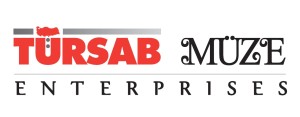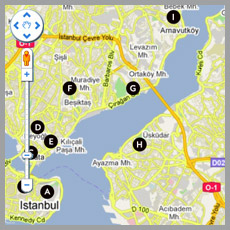By Sevinç Akyazılı
The Chora Museum is one of Eastern Roman (Byzantine) Empire’s greatest gifts not only to Istanbul but to the entire mankind. The unique feature of this 1500 years old structure are its fine mosaics and frescoes which give you the impression that they would come alive any moment and start to move. Some quarters of the city adorned with the monuments inherited from the three great empires who reigned in İstanbul are indifferent to the notion of time. The Kariye district which extends along the city walls in the vicinity of the Edirnekapı gate is one of such neighbourhoods. This small area is home to the Chora Church, one of the most magnificent specimen of Byzantine architectural heritage. What would be the secret of the attraction of this sumptuous building which resisted all challeng-es of time, earthquakes and invasions for 1500 years and which contin-ues yet to welcome thousands of visitors from all parts of the world? Who built it? And why does it attract people from all over the world? The church was built in memory of holy relics. The construction date of the Chora Church could not be established with precision. However, according to medieval Greek writer Symeon Metaphrastes who lived in the 10th century, the church was built on the emplacement of a holy graveyard. Symeon Metaphrastes indicates that it was the burial ground of the relics belonging to the Holy Martyr Baby-las executed in Nicomedia in 298 with his 84 disciples.
The Chora Church was originally built outside the walls of Constantino-ple, to the south of the Golden Horn. Literally translated, the church’s full name was the Church of the Holy Saviour in the Country: although “The Church of the Holy Redeemer in the Fields” would be a more natural rendering of the name in English. The last part of that name, Chora, referring to its location originally outside of the walls, became the shortened name of the church. But, the church turned into ruins shortly after and only its chapel survived. In the sixth century, Eastern Roman Emperor Justinianus (527-565) had it re-built. Designed by the best architects of its period, the church is mentioned in texts dating from 740. But, the majority of the fabric of the current building dates from 1077-1081, when Maria Dukaina, the mother-in-law of Emperor Alexius I Comnenus, restored the Chora Church dedicated to Jesus Christ and Mother Mary. However, it was only after the third phase of building, two centuries after, that the church as it stands today was completed. The powerful Byzantine statesman (Logothete=Secretary of State) Theodore Metochites en-dowed the church with much of its fine mosaics and frescoes.
A sea of mosaics :
The impressive decoration of the interior, ordered by art enthusiast statesman Theodore Metochites, was carried out between 1315 and 1321 and reflect the last golden period of Byzantine art. Decorated inside with marble panels, extraordinary mosaics and frescoes, the church was turned into a sea of mosaics adorned with pastel, gold, pur-ple, blue, lilac colours. Although the artists remain unknown, historians of art suggest that the architectural solutions of the structure surpass the knowledge level of their time, that the background elements used to add depth to the mosaics and frescoes are work of genius. And ac-cording to art historians, the mosaic-work is the finest example of the Palaeologian Renaissance or Byzantine Renaissance.
The Holy Book in stone :
The masterpiece mosaics reflect episodes from the Old Testament as well as from the Bible with an extreme realism comparable to detailed movie scenes. The stories are presented in chronological order with a view to educating the church congregation on the history of Christian-ity. This is the reason why the Chora Church is also referred to as the “Holy Book in stone”. The exonarthex (or outer narthex), the first part of the church that one enters (where the clergy prepared themselves before the ritual) is deco-rated with mosaics reflecting the life of the Christ. The esonarthex (or inner narthex) is decorated with episodes from the life of Virgin Mary. Jesus Christ is depicted from his early childhood up to his adult age when he offers miracles. On the dome located on the left side of the in-ner narthex, Mother Mary holding Jesus child in her arms is surrounded by holy figures. The other mosaic is depicting Mary as a young girl being presented to the priest Zacharias. A mosaic of enthroned Christ with Theodore Metochites presenting him a model of his church is placed on the pediment of the main entrance. Jesus is holding the Bible in his left hand while he gives the benediction with his right hand.
At the chapel, one can admire the frescoes describing scenes from the Old Testament, the Day of Judgment, the Resurrection, the Final Judg-ment. The gigantic frames composed of thousands of mosaic pieces smaller than one square centimetre each and various frescoes narrate in finest detail the episodes from the holy books. The Chora Church became a masterpiece of art through the dedicated work of architects, mosaic masters and marble carvers. The mansions of wealthy and noble citizens of Byzantium built around and near the Chora Church attributed even a greater prestigious character to the neighbourhood. Magnificent stone craftsmanship Marble carving craftsmanship is yet another remarkable aspect of Chora’s decoration in addition to the mosaics and frescoes which contributed to its fame. White marble with gray streaks from the Island of Marmara(ancient Prokonnessos) as well as green and red marble, onyx with pink and yellow streaks from Northern Africa, Afyon (ancient Akroinon) and the Island of Euboea (Eğriboz) were used on the walls, arches and friezes giving the building an internal appearance quite rich in colours.
The streaks in the marble blocs cut into symmetrical sheets placed next to each other constitute a texture similar to wood lining. Under the protection of Sultan Mehmet the Conqueror Following the conquest of the city by the Ottomans in 1453, initiating a new era in world history, Fatih Sultan Mehmet, Sultan Mehmet II the Conqueror allowed the Chora Church, second in importance only to the Hagia Sophia, to remain at the service of the Christian population of Istanbul. The conversion of the church into a mosque occurred later during the reign of Sultan Bayezid I. Grand Vizier Atik Ali Pasha ordered the church to be turned into a mosque in 1511 under the name of Kariye Camii (Kariye Mosque). Some of the mosaics, particularly those depict-ing angels’ faces were overlaid with stucco… At the beginning of the 20Th century, the Russian Academy of Sciences’ Institute of Archaeology and later American Byzantine Studies scholars conducted some restoration work on the mosaics. Finally, in 1945, the building was inaugurated as a museum. Since then, thousands of visitors rush into the museum to embark upon a journey through time guided by the marvellous mosaics.
This article has originally appeared in “Müze” Magazine, published quarterly with the contributions of the Ministry of Culture and Tourism. We would like to thank TÜRSAB Museum Enterprises for sharing this piece with Istanbul Digital Platform followers.




















